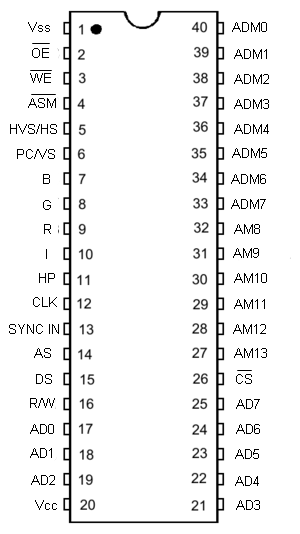
The Atari 7800 ProSystem, or simply the Atari 7800, is a home video game console officially released by Atari Corporation in 1986 as the successor to both the Atari 2600 and Atari 5200. It can run almost all Atari 2600 cartridges, making it one of the first consoles with backward compatibility. It shipped with a different model of joystick from the 2600-standard CX40 and Pole Position II as the pack-in game. Most of the announced titles at launch were ports of 1981–83 arcade video games.

The Intellivision is a home video game console released by Mattel Electronics in 1979. The name is a portmanteau of "intelligent television". Development began in 1977, the same year as the launch of its main competitor, the Atari 2600. In 1984, Mattel sold its video game assets to a former Mattel Electronics executive and investors, eventually becoming INTV Corporation. Game development ran from 1978 to 1990 when the Intellivision was discontinued. From 1980 to 1983, more than 3 million consoles were sold.

The Original Chip Set (OCS) is a chipset used in the earliest Commodore Amiga computers and defined the Amiga's graphics and sound capabilities. It was succeeded by the slightly improved Enhanced Chip Set (ECS) and greatly improved Advanced Graphics Architecture (AGA).

Video Graphics Array (VGA) is a video display controller and accompanying de facto graphics standard, first introduced with the IBM PS/2 line of computers in 1987, which became ubiquitous in the IBM PC compatible industry within three years. The term can now refer to the computer display standard, the 15-pin D-subminiature VGA connector, or the 640×480 resolution characteristic of the VGA hardware.

The VIC (Video Interface Chip), specifically known as the MOS Technology 6560 (NTSC version) / 6561 (PAL version), is the integrated circuit chip responsible for generating video graphics and sound in the VIC-20 home computer from Commodore. It was originally designed for applications such as low cost CRT terminals, biomedical monitors, control system displays and arcade or home video game consoles.

The VIC-II, specifically known as the MOS Technology 6567/6566/8562/8564, 6569/8565/8566 (PAL), is the microchip tasked with generating Y/C video signals and DRAM refresh signals in the Commodore 64 and Commodore 128 home computers.

The Color Graphics Adapter (CGA), originally also called the Color/Graphics Adapter or IBM Color/Graphics Monitor Adapter, introduced in 1981, was IBM's first color graphics card for the IBM PC and established a de facto computer display standard.

The X68000 is a home computer created by Sharp Corporation. It was first released in 1987 and sold only in Japan.

The TMS9918 is a video display controller (VDC) manufactured by Texas Instruments, in manuals referenced as "Video Display Processor" (VDP) and introduced in 1979. The TMS9918 and its variants were used in the ColecoVision, CreatiVision, Memotech MTX, MSX, NABU Personal Computer, SG-1000/SC-3000, Spectravideo SV-318, Spectravideo SV-328, Sord M5, Tatung Einstein, Texas Instruments TI-99/4, Casio PV-2000, Coleco Adam, Hanimex Pencil II, and Tomy Tutor.

The PC Engine SuperGrafx, also known as simply the SuperGrafx, is a fourth-generation home video game console manufactured by NEC Home Electronics and released in Japan in 1989. It is the successor system to the PC Engine, released two years prior. Originally known as the PC Engine 2 during production stages, it was purported as a true 16-bit home console, featuring improved graphics and audio capabilities over its predecessor.

Color Television Interface Adaptor (CTIA) and its successor Graphic Television Interface Adaptor (GTIA) are custom chips used in the Atari 8-bit family of computers and in the Atari 5200 home video game console. In these systems, a CTIA or GTIA chip works together with ANTIC to produce the video display. ANTIC generates the playfield graphics while CTIA/GTIA provides the color for the playfield and adds overlay objects known as player/missile graphics (sprites). Under the direction of Jay Miner, the CTIA/GTIA chips were designed by George McLeod with technical assistance of Steve Smith.

Hold-And-Modify, usually abbreviated as HAM, is a display mode of the Commodore Amiga computer. It uses a highly unusual technique to express the color of pixels, allowing many more colors to appear on screen than would otherwise be possible. HAM mode was commonly used to display digitized photographs or video frames, bitmap art and occasionally animation. At the time of the Amiga's launch in 1985, this near-photorealistic display was unprecedented for a home computer and it was widely used to demonstrate the Amiga's graphical capability. However, HAM has significant technical limitations which prevent it from being used as a general purpose display mode.

The TurboDuo is a fourth-generation video game console developed by NEC Home Electronics and Hudson Soft for the North American market. The TurboDuo was test-marketed in Los Angeles in October 1992, before a nationwide rollout in May 1993. It is the North American version of the Japanese PC Engine Duo game console which was released in September 1991.
Composite artifact colors is a designation commonly used to address several graphic modes of some 1970s and 1980s home computers. With some machines, when connected to an NTSC TV or monitor over composite video outputs, the video signal encoding allowed for extra colors to be displayed, by manipulating the pixel position on screen, not being limited by each machine's hardware color palette.

The Orion-128 is a DIY computer designed in Soviet Union. It was featured in the Radio magazine in 1990, other materials for the computer were published until 1996. It was the last Intel 8080-based DIY computer in Russia.

The EF9345 from SGS-Thomson Microelectronics, Inc., was a semigraphic microprocessor for video image control, encapsulated in a 40-pin DIP and used primarily in the Matra Alice 32, Matra Alice 90 and Philips VG5000 microcomputers.













